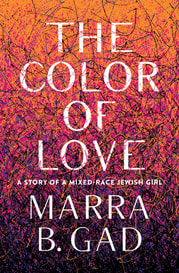“There are two things that happen when someone is trying to decide [...] where they are going to put your otherness,” Marra B. Gad writes in her new book The Color of Love. “For some, there is a blankness in the eyes that takes over, as if they are lost in thought,” but for others, “there is an immediate narrowing, a sharpness that engages. And it is because they don’t need to think.” For Marra, these two reactions encompassed much of her world. In the prologue, Marra describes her background as a mixed Jewish woman, half white and half black, who was adopted by a Jewish family in 1970. To Marra, the labels she identifies with don’t matter, shouldn’t matter, yet, “For many, identity is literally a black-and-white matter.” Something that is, or isn’t. But this simplistic view of identity is not only wrong, but harmful. In her memoir, Marra describes the many occasions she was discriminated against because of her race or religion. Often, these actions would come from members of her own community; family members made racist remarks, African-Americans felt she wasn’t “black enough,” Jewish people didn’t believe she was Jewish, state officials didn’t believe she was related to her white family. Marra, whose identity lies between these black-and-white boundaries, writes, “we must choose how to manage what comes when we are ‘othered’ by . . . others.” The Color of Love is this story, a story of how Marra grappled her identity, and herself, while being rejected by her communities.
The Color of Love is important to the conversations today discussing race and religion. Even though much of this book takes place in the 80’s and early 2000’s, minorities still face microaggressions and discrimination regularly. Discrimination is often described, if not assumed, as things the “in-group” does to the “out-group.” But there is much more nuance in society, and in everyday interactions. The Color of Love depicts situations where the “out-group” discriminates against another “out-group.” In Marra’s story, she faced religious discrimination because of her race and racial discrimination because of her religion. At the center of this discrimination, which is explored throughout the story, is the relationship between Marra and her great-aunt Nette. Nette takes particular displeasure in Marra’s race. In the first scene of chapter one, Nette tells Marra at her sister’s wedding that “nothing is worse than being black.” Despite Nette’s hate and mistreatment of Marra, she is a central figure in The Color of Love. Marra describes how she looked up to Nette as a figure of womanhood and independence throughout her childhood and adult life. But pleasing Nette was like trying to fit into ever-growing shoes that Nette made for her, a futile attempt to fulfill the expectations of a woman who, upon her first look, decided how to act without thinking. It is in this way that many minorities, and in this case, Marra, walk an impossibly thin line trying to please their discriminators, trying desperately to gain their love. For Marra, this was a lifelong journey. Along the way, Nette begins to show signs of Alzheimers’s Disease, which increasingly grows worse. When the time comes and Nette can no longer care for herself, Marra realizes, “I had never considered what I might do if someone who had been painfully cruel to me needed my help under stressful circumstances. But when I found myself having to decide, the choice was clear.” Marra takes it upon herself to care for Nette, partly because she is the only person able to do so, but also because she feels it is the right thing to do. Facing her aggressor head on, Marra cares for Nette with grace, never anger, through her final days. “I choose love. Always.” says Marra B. Gad. Throughout her life, Marra faced discrimination of all kinds, from all sides. Instead of becoming “an instrument that puts more hate into the world,” Marra turned, again and again, to love. “Holding on to the anger is often not a conscious thing, for public discussions about the nuanced challenges of being mixed race are only just beginning. And until very recently, there has not been a space to talk about it and how it affects us, especially those of us who live at the intersection of race and religion in the way that I do.” The Color of Love provides a much needed voice to this space in society today. But maybe even more than this, Marra’s story serves as a reminder, a guide for all of us, from all backgrounds, to choose love. Always.
0 Comments
Leave a Reply. |
Archives
July 2024
Categories
All
|
|
Glassworks is a publication of Rowan University's Master of Arts in Writing 260 Victoria Street • Glassboro, New Jersey 08028 [email protected] |
All Content on this Site (c) 2024 Glassworks
|


 RSS Feed
RSS Feed
